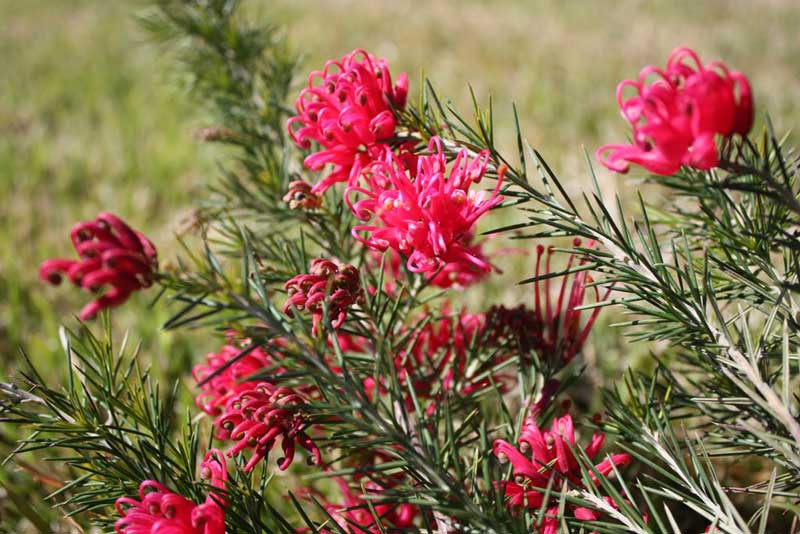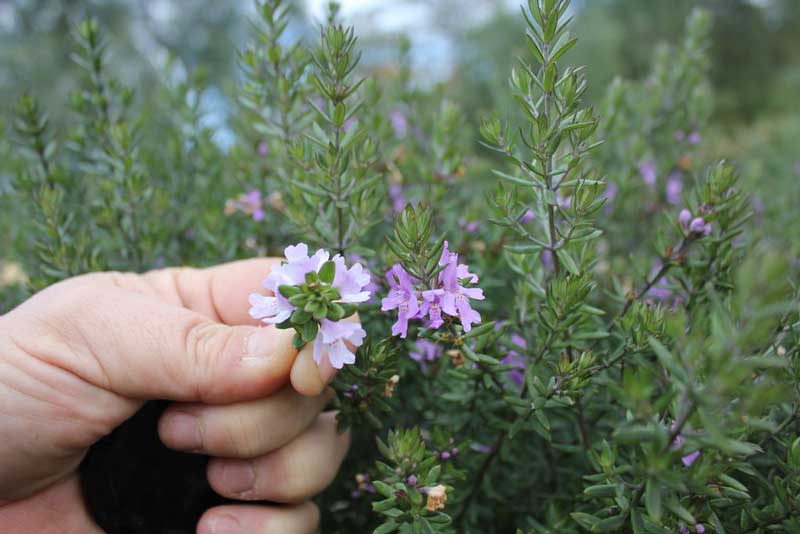If you’d like your Aussie garden to be filled with colour all year, you’ll benefit greatly from adding plants that bloom in winter. Sure, foliage is one way to add colour, but many pollinators are still active during the cooler months and there is no substitute for flowers.
But most plants only flower in the warmer months, so which plants should you choose?
Native Australian Winter Bloomers
There are a number of native plants that shine during the colder months, showcasing their ability to grace the garden with colour when it’s needed most. Each of these headings relates to the genus level, which is an over-simplification. Some species and varieties within the same genus will perform differently – and even the climate, soil, sunlight availability, and general level of care can extend flowering timelines as well.
Grevillea spp.
Grevilleas, with their nectar-rich, spider-like blooms, are a magnet for native wildlife. Ranging from prostrate ground covers to tall trees, there’s a grevillea to fit any space.
This grevillea is one of the showiest winter-flowering plants in the world. Crimson Villea™ Grevillea rosmarinifolia ‘H16’ PBR. Read more about it here: https://www.ozbreed.com.au/plant-ranges/native-shrubs-groundcovers/crimson-villea-grevillea/

Hakea spp.
The spherical blooms of pincushion hakea (Hakea laurina) are particularly spectacular, adding a touch of intrigue and colour to the winter garden landscape.
Banksia spp.
The candle-like inflorescences of the Banksia genus not only captivate the eye but also attract essential pollinators, contributing to the biodiversity of the garden.
Correa spp. (Australian Fuchsia)
Correa species, known as Australian fuchsias, their bell-shaped flowers add a touch of elegance to the winter garden.
This correa is more resilient than other varieties, with beautiful clean pink flowers and a stronger growth habit. Coastal Pink™ Correa alba ‘COR10’ PBR. Read more about it here: https://www.ozbreed.com.au/plant-ranges/native-shrubs-groundcovers/coastal-pink-correa-copes-well-with-coastal-winds/

Acacia spp. (Wattles)
Acacia species, commonly known as wattles, play a fundamental role in Australia’s ecosystems. With over 1,000 species spread across diverse habitats, these plants bloom at various times, including some species that flower during the winter months. The vibrant yellow flowers of winter-flowering wattles brighten up the garden, contrasting beautifully against the subdued winter backdrop. In addition to their visual appeal, Wattles enrich the soil by fixing nitrogen, supporting the overall health of the garden. Ranging from small shrubs to towering trees, wattles bring versatility and charm to any landscape.
Exotic Winter Wonders
Some winter-flowering non-native plants can thrive in Australian climates, increasing your available plant palette.
Aloe spp.
Aloe flowers are quite spectacular, standing on tall stems above the rosette of succulent, spiky foliage. Use them to provide architectural structure within your garden beds, and watch our native nectarivorous birds feeding on them while they’re in bloom.
This aloe is a lot more resilient than other varieties. As well as tolerating drought, it can tolerate periodic wet feet, frost, and even clay-dominant soils if you amend them with a bit of gypsum and organic matter. Mighty Gold™ Aloe hybrid ‘AL02’ PBR. Read more about it here: https://www.ozbreed.com.au/plant-ranges/hardy-exotic-range/mighty-gold/

Camellia spp.
Camellias can flower in late autumn, winter, or early spring, depending on the cultivar. Their floral colour is usually pink, with some varieties featuring white or yellow blooms.
Daphne odora
These evergreen winter-flowering plants release one of the most exquisite scents you’ll ever experience. Native to China, these plants bloom from winter through to late spring and show off glossy green foliage throughout the whole year.
Champions of Year-Round Color
Some plants will flower all year round, including during winter. They may flower more profusely during the warmer months, but they still bring the colour when most other plants are taking it easy.
Scaevola spp.
Many scaevola cultivars will bloom for most of the year, from late spring through winter. Their fan-shaped flowers are a favourite among bees and other insect pollinators.
This scaevola is one of the toughest plants in the world, which will thrive in the toughest of soils. Pink Fusion™Scaevola spp. ‘PFS200’ PBR Intended. Read more about it here: https://www.ozbreed.com.au/plant-ranges/native-shrubs-groundcovers/pink-fusion/

Lavandula spp. (lavender)
Lavender plants are related to many of our favourite herbs, in the family Lamiaceae. They’re highly fragrant and a staple in cottage garden designs.
Pelargonium spp. & Geranium spp.
Pelargoniums and geraniums are closely related, and there are a range of varieties which will bloom year round. Some will flower all through winter as well.
Salvia spp.
Another mint-family (Lamiaceae) member, salvias are another plant that will often flower throughout winter, although they’ll generally bloom a lot more abundantly throughout the warmer months.
Westringia
Westringias, also known as native rosemary or coastal rosemary, are another Lamiaceae family member that will often flower right through winter, providing a food source for our native birds and insects.
This westringia has beautiful, blue/purple flowers that appear abundantly throughout most of the year, including winter. It’s the most vidid flowering westringia we’ve ever come across. Blue Gem™ Westringia hybrid ‘WES03’ PBR. Read more about it here: https://www.ozbreed.com.au/plant-ranges/native-shrubs-groundcovers/blue-gem-westringia-is-a-native-shrub-with-vivid-bluish-purple-flowers-native-shrubs-ground-covers/

Conclusion
Hopefully this article has widened your palette of winter-flowering plants for your next gardening project. Whether you’re looking to provide a more consistent resource for wildlife, or you’d just like to cheer up a dreary garden in the cooler months, mix and match different plants to create a plant palette that reflects your own personal style.
Remember that each species or cultivar within a genus will have its own preferences, and even its own flowering timeline. Some plants will perform differently than you’d expect just going off the genus alone, so check for any information online or on your plant’s label.
